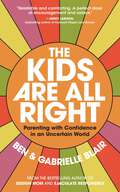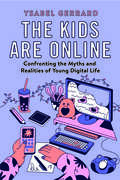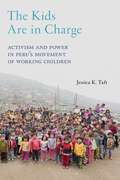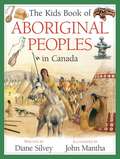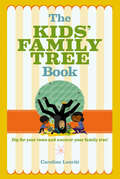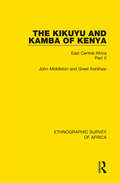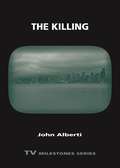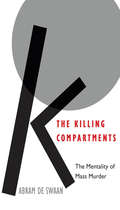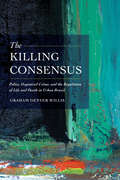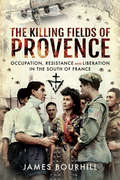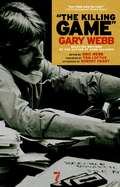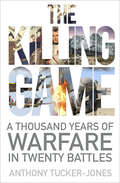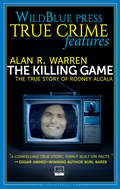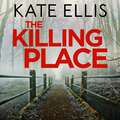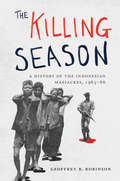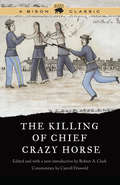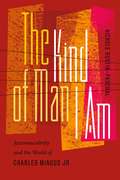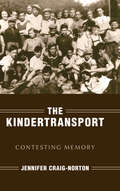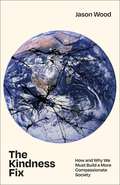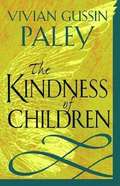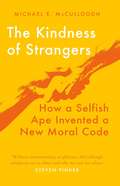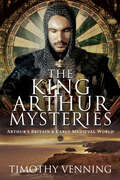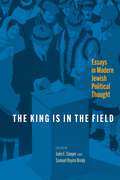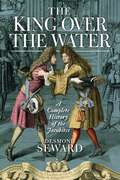- Table View
- List View
The Kids Are All Right: Parenting with Confidence in an Uncertain World
by Gabrielle Stanley Blair Ben BlairFrom Design Mom blogger Gabrielle Blair and her husband, Ben Blair, a unique guide that subverts the concept of "perfect parenting" by embracing uncertainty. Gabrielle and Ben Blair have been raising kids for over two decades. Through the years, they&’ve charted their own unconventional path: working from home before remote work was a thing; uprooting their kids four, five, six times – including a move to France where they enrolled in local schools without knowing the language. It&’s been a unique parenting journey characterized by experimentation, trial and error, decisions prompted by financial or psychological necessity, varying levels of anxiety and tension, despair, and hope. This unique path turned out to be fertile soil for growing independent, resilient, and creative kids, and a family that is genuinely close and truly enjoys each other&’s company. With this book they share how they did it, and how we can too: by letting go of tired expectations of what it means to be a good parent (focus less on grades and more on seeing your kid for who they are); by accepting that the old rules won&’t necessarily apply in the future (changes in higher ed and career-building are evolving at a rapid pace) and instead focus on making your time with your kids one of connection, adventure, shared projects, creativity and joy. And it doesn&’t require moving to France!
The Kids Are Online: Confronting the Myths and Realities of Young Digital Life
by Ysabel GerrardA nuanced, intimate picture of how young people live with and on social media. Today's young people find themselves at the center of widespread debates about their online safety, and they are often told that social media platforms affect their mental health and body image by exposing them to cyberbullying and distressing images. Foregrounding their voices and experiences, The Kids Are Online explores how they navigate their identities across platforms and how they really feel about their young digital lives. Ysabel Gerrard talked to more than a hundred teens to unpack the myths and realities of their social media use. Instead of framing today's big platforms as either good or bad, she identifies moments when young people encounter social apps in paradoxical ways—both good and bad at the same time. Using the concepts of stigma, secrecy, safety, and social comparison, she helps readers understand young people's experiences. The Kids Are Online proposes a series of recommendations for parents, families, schools, technology companies, and policymakers to imagine how we might build safer social media systems.
The Kids Are in Charge: Activism and Power in Peru's Movement of Working Children (Critical Perspectives on Youth #2)
by Jessica K. TaftDetails the possibilities and challenges of intergenerational activism and social movements Since 1976, the Peruvian movement of working children has fought to redefine age-based roles in society, including defending children’s right to work. In The Kids Are in Charge, Jessica K. Taft gives us an inside look at this groundbreaking, intergenerational social movement, showing that kids can—and should be—respected as equal partners in economic, social, and political life. Through participant observation, Taft explores how the movement has redefined relationships between kids and adults; how they put these ideas into practice within their organizations; and how they advocate for them in larger society. Ultimately, she encourages us to question the widely accepted beliefs that children should not work or participate in politics. The Kids Are in Charge is a provocative invitation to re-imagine childhood, power, and politics.
The Kids Book Of Aboriginal Peoples In Canada (Kids Book Of )
by John Mantha Diane SilveyCanada's Aboriginal peoples have shaped this country in countless ways. Their story is central to the nation's identity --- indeed, the word ?Canada? is derived from the Huron-Haudenosaunee word ?kanata,? which means ?our village.? This title in the acclaimed Kids Book of series is a balanced, in-depth look at the cultures, struggles and triumphs of Canada's first peoples. <P><P> Exhaustively researched and reviewed by specialists in the field, this groundbreaking book is by far the most comprehensive of its kind. The detailed illustrations based on museum artifacts, written records of long ago and contemporary scholarship help bring the traditional ways to life for young readers.
The Kids' Family Tree Book
by Caroline LeavittDig deep into your family history with the updated edition of this popular, informative guide!Who are my ancestors? What nationalities were they? What work did they do? Kids are always bursting with questions about their family history; they want more stories, more details, more facts. With these research ideas and creative projects, young would-be genealogists can get the knowledge they crave. Find out how to gather ancestry information on the Internet, interview family members, reach relatives through social media, check the National Archives for passenger lists of newly arrived immigrants, and uncover clues in old photos and records. Preserve the material you've gathered in an online scrapbook or create a crayon batik family tree. Keep the togetherness going by planning a family reunion, starting a family newsletter, and more.
The Kikuyu and Kamba of Kenya: East Central Africa Part V
by John Middleton Greet KershawRoutledge is proud to be re-issuing this landmark series in association with the International African Institute. The series, originally published between 1950 and 1977, collected ethnographic information on the peoples of Africa, using all available sources: archives, memoirs and reports as well as anthropological research which, in 1945, had only just begun. Concise, critical and (for its time) accurate, the Ethnographic Survey contains sections as follows: Physical Environment Linguistic Data Demography History & Traditions of Origin Nomenclature Grouping Cultural Features: Religion, Witchcraft, Birth, Initiation, Burial Social & Political Organization: Kinship, Marriage, Inheritance, Slavery, Land Tenure, Warfare & Justice Economy & Trade Domestic Architecture Each of the 50 volumes will be available to buy individually, and these are organized into regional sub-groups: East Central Africa, North-Eastern Africa, Southern Africa, West Central Africa, Western Africa, and Central Africa Belgian Congo. The volumes are supplemented with maps, available to view on routledge.com or available as a pdf from the publishers.
The Killing (TV Milestones Series)
by John AlbertiAlthough it lasted only four seasons and just forty-four episodes, The Killing attracted considerable critical notice and sparked an equally lively debate about its distinctive style and innovative approach to the television staple of the police procedural. A product of the turn toward revisionist “quality” television in the post-broadcast era, The Killing also stands as a pioneering example of the changing gender dynamics of early twenty-first-century television. Author John Alberti looks at how the show’s focus shifts the police procedural away from the idea that solving the mystery of whodunit means resolving the crime, and toward dealing with the ongoing psychological aftermath of crime and violence on social and family relationships. This attention to what creator and producer Veena Sud describes as the “real cost” of murder defines The Killing as a milestone feminist revision of the crime thriller and helps explain why it has provoked such strong critical reactions and fan loyalty. Alberti examines the history of women detectives in the television police procedural, paying particular attention to how the cultural formation of the traditionally male noir detective has shaped that history. Through a careful comparison with the Danish original, Forbrydelsen, and a season-by-season overview of the series, Alberti argues that The Killing rewrites the masculine lone wolf detective—a self-styled social outsider who sees the entanglements of relationships as threats to his personal autonomy—of the classic noir. Instead, lead detective Sarah Linden, while wary of the complications of personal and social attachments, still recognizes their psychological and ethical inescapability and necessity. In the final chapter, the author looks at how the show’s move to ever-expanding niche markets and multi-viewing options, along with an increase in feminist reconstructions of various television genres, makes The Killing a perfect example of cult television that lends itself to binge-watching in the digital era. Television studies scholars and fans of police procedurals should own this insightful volume.
The Killing Compartments
by Abram De SwaanThe twentieth century was among the bloodiest in the history of humanity. Untold millions were slaughtered. How people are enrolled in the service of evil is a question that continues to bedevil. In this trenchant book, Abram de Swaan offers a taxonomy of mass violence that focuses on the rank-and-file perpetrators, examining how murderous regimes recruit them and create what De Swaan calls the "killing compartments” that make possible the worst abominations without apparent moral misgiving, without a sense of personal responsibility, and, above all, without pity. De Swaan wonders where extreme violence comes from and where it goes#151;seemingly without a trace#151;when the wild and barbaric gore is over. And what about the perpetrators themselves? Are they merely and only the product of external circumstance? Or is there something in their makeup that disposes them to become mass murderers? Drawing on a wide range of disciplines, including sociology, anthropology, political science, history, and psychology, De Swaan sheds new light on an urgent and intractable pathology that continues to poison peoples all over the world.
The Killing Consensus
by Graham Denyer WillisWe hold many assumptions about police work--that it is the responsibility of the state, or that police officers are given the right to kill in the name of public safety or self-defense. But in The Killing Consensus, Graham Denyer Willis shows how in São Paulo, Brazil, killing and the arbitration of "normal" killing in the name of social order are actually conducted by two groups--the police and organized crime--both operating according to parallel logics of murder. Based on three years of ethnographic fieldwork, Willis's book traces how homicide detectives categorize two types of killing: the first resulting from "resistance" to police arrest (which is often broadly defined) and the second at the hands of a crime "family' known as the Primeiro Comando da Capital (PCC). Death at the hands of police happens regularly, while the PCC's centralized control and strict moral code among criminals has also routinized killing, ironically making the city feel safer for most residents. In a fractured urban security environment, where killing mirrors patterns of inequitable urbanization and historical exclusion along class, gender, and racial lines, Denyer Willis's research finds that the city's cyclical periods of peace and violence can best be understood through an unspoken but mutually observed consensus on the right to kill. This consensus hinges on common notions and street-level practices of who can die, where, how, and by whom, revealing an empirically distinct configuration of authority that Denyer Willis calls sovereignty by consensus.
The Killing Fields of Provence: Occupation, Resistance and Liberation in the South of France
by James BourhillA history of the German occupation of France during World War II, the French resistance, and ultimately the nation’s liberation.In the south of France, the most memorable event of World War II was the sea and airborne invasion of August 15, 1944. Perhaps because it went relatively smoothly, this “Second D-Day” was soon relegated to the back pages of history. Operation Dragoon and the liberation are, however, only a small part of the story. The arrival of the Allies was preceded by years of suffering and sacrifice under Hitléro-Vichyssois oppression.Provençale people still struggle to come to terms with the painful past of split-allegiances and empty stomachs that epitomize les années noirs (the dark years). Deportations, requisitions, forced labor, and hunger provoked resistance by a courageous minority. Many actively colluded with the enemy, but most just waited for better days. By sea and air, Allied agents and special forces were infiltrated to fan the flames, but wherever the Resistance arose prematurely, the reprisals from the Nazis and their auxiliaries were ferocious.In every corner of Provence, one can find words chipped into stone: Passant, souviens-toi (passer-by, remember). It is hard to imagine such cruelty could have existed here less than one generation ago. These memories here tell a story of duplicity, defiance, and ultimately, deliverance. Whether the stuff of legends, or the experiences of everyday humans, humanity is used to explain the Franco-American experience of wartime Provence, as seen through an Anglo-Saxon prism.“A complete and well-researched study of the French Resistance groups, Allied agents and Special Forces operating against the Germans in the South of France.” —Firetrench
The Killing Game
by Gary WebbGary Webb had an inborn journalistic tendency to track down corruption and expose it. For over thirty-four years, he wrote stories about corruption from county, state, and federal levels. He had an almost magnetic effect to these kinds of stories, and it was almost as if the stories found him. It was his gift, and, ultimately, it was his downfall.He was best known for his story Dark Alliance, written for the San Jose Mercury News in 1996. In it Webb linked the CIA to the crack-cocaine epidemic in Los Angeles during the Iran Contra scandal. His only published book, Dark Alliance is still a classic of contemporary journalism. But his life consisted of much more than this one story, and The Killing Game is a collection of his best investigative stories from his beginning at the Kentucky Post to his end at the Sacramento News & Review. It includes Webb's series at the Kentucky Post on organized crime in the coal industry, at the Cleveland Plain Dealer on Ohio State's negligent medical board, and on the US military's funding of first-person shooter video games. The Killing Game is a dedication to his life's work outside of Dark Alliance, and it's an exhibition of investigative journalism in its truest form.
The Killing Game: A Thousand Years of Warfare in Twenty Battles
by Anthony Tucker-JonesThe second millennium of mankind has been characterized by almost incessant warfare somewhere on the face of the globe. This book serves as a snapshot of the development of warfare over the past 1,000 years, illustrating the bravery and suffering mankind has inflicted upon itself in developing what we call the "Art of War." Here military historian Anthony Tucker-Jones selects 20 battles that illustrate the changing face of warfare over the past thousand years—from the Viking shield wall to long bows and knights, the emergence of gunpowder, and finally the long-range faceless warfare of today. International in scope, it covers such well-known battles as Crecy (1346), Magdeburg (1631), Falkirk (1746), Isandlwana (1879), the Blitz (1940), Bekaa Valley (1982), Tora Bora (2001), and more.
The Killing Game: The True Story of Rodney Alcala (WildBlue Press True Crime)
by Alan R. WarrenThe &“compelling true story&” of &“The Dating Game Killer&” by the radio host and bestselling author of Drinks, Dinner & Death (Burl Barer, Edgar Award-winning author). Beginning in 1968 and continuing into the 1970s, a predator stalked California and New York, torturing, raping and murdering young girls and women. But who was the monster behind these tragedies? Eventually, a suspect emerged, but he didn&’t look like a monster. Indeed, Rodney Alcala was a handsome, charming photographer who&’d once studied film at New York University under director Roman Polanski. With his wit and easy self-confidence and humor, he&’d even been selected as the &“winner&” on the popular television show &“The Dating Game.&” But his real game was much more sinister. In 2010, Alcala was convicted of murdering five women in California during the 1970s; then in 2013, as he waited on Death Row, he confessed to the murder of two more in New York. Yet, that might not be the end of the nightmare he caused. At his arrest, police found his &“portfolio&” with thousands of nude and erotic photographs of women and boys, who may also be among his victims. In The Killing Game, bestselling true crime author and radio show host, Alan R. Warren reveals the shocking details of Alcala&’s brutal crimes, as well as the trials and appeals that stretched on for decades and may still not be over.
The Killing Place: Book 27 in the DI Wesley Peterson crime series (DI Wesley Peterson #27)
by Kate EllisMillion-copy bestselling author Kate Ellis returns with the brand new book in the DI Wesley Peterson crime series.'A beguiling author who interweaves past and present' THE TIMESNovember. With the tourist season well and truly over in South Devon, Detective Inspector Wesley Peterson is looking forward to a quieter month in the CID. But when a man is shot dead on Bonfire Night, he finds he has a disturbing murder case on his hands. The body of Patrick North was found in woodland connected to Nesbaraton Hall, a grand estate dating back to the eighteenth century. North worked for the Smithson family who now own the estate. The family are away on holiday, however when an anonymous letter threatening to abduct the Smithson son is uncovered, Wesley fears North's death might have been collateral damage in a kidnap plot.Meanwhile, archaeologist Dr Neil Watson discovers a hidden grotto on land that was once part of the Nesbaraton estate. Evidence of past rituals and the shocking discovery of a skeleton raise questions about strange occurrences, past and present, on the land.Then, just when Wesley's team seem to be making progress in their investigation, a resident of the nearby village is killed in a near-identical shooting to North's. A race is on to find the ruthless killer, before they strike again . . .Whether you've read the whole series, or are discovering Kate Ellis's DI Wesley Peterson novels for the first time, this is the perfect page-turner if you love reading Ann Cleeves and Elly Griffiths.Praise for Kate Ellis . . .'Clever plotting hides a powerful story of loss, malice and deception' Ann Cleeves'Haunting' Independent'The chilling plot will keep you spooked and thrilled to the end' Closer'Unputdownable' Bookseller'A fine storyteller, weaving the past and present in a way that makes you want to read on' Peterborough Evening Telegraph
The Killing Season: A History of the Indonesian Massacres, 1965-66
by Geoffrey B. RobinsonThe Killing Season explores one of the largest and swiftest, yet least examined, instances of mass killing and incarceration in the twentieth century—the shocking antileftist purge that gripped Indonesia in 1965–66, leaving some five hundred thousand people dead and more than a million others in detention.An expert in modern Indonesian history, genocide, and human rights, Geoffrey Robinson sets out to account for this violence and to end the troubling silence surrounding it. In doing so, he sheds new light on broad and enduring historical questions. How do we account for instances of systematic mass killing and detention? Why are some of these crimes remembered and punished, while others are forgotten? What are the social and political ramifications of such acts and such silence?Challenging conventional narratives of the mass violence of 1965–66 as arising spontaneously from religious and social conflicts, Robinson argues convincingly that it was instead the product of a deliberate campaign, led by the Indonesian Army. He also details the critical role played by the United States, Britain, and other major powers in facilitating mass murder and incarceration. Robinson concludes by probing the disturbing long-term consequences of the violence for millions of survivors and Indonesian society as a whole.Based on a rich body of primary and secondary sources, The Killing Season is the definitive account of a pivotal period in Indonesian history. It also makes a powerful contribution to wider debates about the dynamics and legacies of mass killing, incarceration, and genocide.
The Killing Streets: Uncovering Australia's first serial murderer
by Tanya Bretherton**WINNER OF THE 2020 DANGER PRIZE**From the acclaimed author of THE SUITCASE BABY and THE SUICIDE BRIDE, the fascinating story of a series of horrific murders that began in 1930s Sydney - and a killer who remained at large for over two decades.In December 1932, as the Depression tightened its grip, the body of a woman was found in Queens Park, Sydney. It was a popular park. There were houses in plain view. Yet this woman had been violently murdered without anyone noticing. Other equally brutal and shocking murders of women in public places were to follow. Australia's first serial killer was at large.Police failed to notice the similarities between the victims until the death of one young woman - an aspiring Olympic swimmer - made the whole city take notice. On scant evidence, the unassuming Eric Craig was arrested. But the killings didn't stop... A compelling story of a city crippled by fear and what happens when victims are blamed and suspects are presumed guilty, The Killing Streetsinvestigates how a murderer could remain free to kill again.**Includes a BONUS extract from Tanya Bretherton's compelling new book THE HUSBAND POISONER**
The Killing of Chief Crazy Horse, Bison Classic Edition
by Robert A. ClarkThe Killing of Chief Crazy Horse is a story of envy, greed, and treachery. In the year after the Battle of the Little Big Horn, the great Oglala Sioux chief Crazy Horse and his half-starved followers finally surrendered to the U.S. Army near Camp Robinson, Nebraska. Chiefs who had already surrendered resented the favors he received in doing so. When the army asked for his help rounding up the the Nez Percés, Crazy Horse’s reply was allegedly mistranslated by Frank Grouard, a scout for General George Crook. By August rumors had spread that Crazy Horse was planning another uprising. Tension continued to mount, and Crazy Horse was arrested at Fort Robinson on September 5. During a scuffle Crazy Horse was fatally wounded by a bayonet in front of several witnesses. Here the killing of Crazy Horse is viewed from three widely differing perspectives—that of Chief He Dog, the victim’s friend and lifelong companion; that of William Garnett, the guide and interpreter for Lieutenant William P. Clark, on special assignment to General Crook; and that of Valentine McGillycuddy, the medical officer who attended Crazy Horse in his last hours. Their eyewitness accounts, edited and introduced by Robert A. Clark, combine to give The Killing of Chief Crazy Horse all the starkness and horror of classical tragedy.
The Kind of Man I Am: Jazzmasculinity and the World of Charles Mingus Jr. (Music-culture Ser.)
by Nichole Rustin-PaschalNearly four decades after his death, Charles Mingus Jr. remains one of the least understood and most recognized jazz composers and musicians of our time. Mingus’s ideas about music, racial identity, and masculinity—as well as those of other individuals in his circle, like Celia Mingus, Hazel Scott, and Joni Mitchell—challenged jazz itself as a model of freedom, inclusion, creativity, and emotional expressivity. Drawing on archival records, published memoirs, and previously conducted interviews, The Kind of Man I Am uses Mingus as a lens through which to craft a gendered cultural history of postwar jazz culture. This book challenges the persisting narrative of Mingus as jazz’s “Angry Man” by examining the ways the language of emotion has been used in jazz as shorthand for competing ideas about masculinity, authenticity, performance, and authority.
The Kindertransport: Contesting Memory (Studies In Antisemitism Ser.)
by Jennifer Craig-NortonA timely study of the effects of family separation on child refugees, using newly discovered archival sources from the WWII era: “Highly recommended.” —ChoiceThe Kindertransport—an organized effort to extract children living under the threat of Nazism—lives in the popular memory as well as in literature as a straightforward act of rescue and salvation, but these celebratory accounts leave little room for a deeper, more complex analysis. This volume reveals that in fact many children experienced difficulties with settlement: they were treated inconsistently by refugee agencies, their parents had complicated reasons for giving them up, and their caregivers had a variety of motives for taking them in. Against the grain of many other narratives, Jennifer Craig-Norton emphasizes the use of newly discovered archival sources, which include the correspondence of refugee agencies, carers, Kinder and their parents, and juxtaposes this material with testimonial accounts to show readers a more nuanced and complete picture of the Kindertransport. In an era in which the family separation of refugees has commanded considerable attention, this book is a timely exploration of the effects of family separation as it was experienced by child refugees in the age of fascism.
The Kindness Fix: How and Why We Must Build a More Compassionate Society
by Jason WoodIf a measure of our humanity is how we treat the most vulnerable, our report card is bleak. Our politics is divided, people in need are too often treated with cruelty, and the systems we built to support others are creaking. Welfare too often fails, sometimes with tragic consequences. Yet, the help we give to others can be more effective, more accepted, and more just if we cultivate greater levels of compassion to put it at the heart of public life and potentially resolve these challenges. In this book, Jason Wood reviews the research and talks to experts from across the world to make the moving case for greater compassion in public life.
The Kindness of Children
by Vivian Gussin PaleyExploring children's impulsive goodness, Paley lets her listeners and storytellers take us down unexpected paths, where the meeting of story and real life make us wonder: Are children wiser about the nature of kindness than we think they are? The book brings together the moral life of the very young and the very old. Paley's journey takes us into the different worlds of urban London, Chicago, Oakland, and New York City, and to a close-knit small town in Michigan's Upper Peninsula.
The Kindness of Strangers: How a Selfish Ape Invented a New Moral Code
by Michael E. McCulloughWhy do we give a damn about strangers? Altruism is unique to the human species. It is also one of the great evolutionary puzzles, and we may be on the brink of solving it. It turns out that, over the last 12,000 years, we have become more and more altruistic. This is despite the fact that, the majority of the time, our minds are still breathtakingly indifferent to the welfare of others. In solving the enigma of generosity in a world of strangers, McCullough takes us on a sweeping history of society and science to warn that, if we are not careful, our instincts and sympathies have as much potential for harm as for good. The bad news is that we are not designed to be kind. The good news is that we can push ourselves to be kind anyway, together.
The King Arthur Mysteries: Arthur's Britain & Early Medieval World
by Timothy VenningAn up-to-date and comprehensive guide to the history of the Arthurian phenomenon - the imaginary and historical world of the great British warlord and one of the huge historical mysteries of early and medieval Britain. The Arthurian story, based on fact and fiction, is central to Britain's 'creation myth' and the concept of Britain's heroic past. This is a deeply researched and scholarly but essentially accessible history and analysis for general readers and specialists and based on an impressive array of sources including Romano-British, Anglo-Saxon, rare medieval English, French and German sources, and archaeology - essential for modern historical research in early history. Modern and contemporary historiography is covered including 'debunking' treatments. The study surveys King Arthur in fact and fiction, his family, knights, and the legends that have grown up around them and developed to the enduring interest from history, literature to TV and film.
The King Is in the Field: Essays in Modern Jewish Political Thought (Jewish Culture and Contexts)
by Julie E. Cooper and Samuel Hayim BrodyIf politics is about the state, can a stateless people be political? Until recently, scholars were fiercely divided regarding whether Jews engaged in politics, displayed political wisdom, or penned works of political thought over the two millennia when there was no Jewish state. But over the past few decades, the field of Jewish political thought has begun to examine the ways in which Jewish individuals and communal organizations behaved politically even in diaspora.The King Is in the Field centers writing from leading scholars that serves as an introduction to this exciting field, providing critical resources for anyone interested in thinking about politics both within and beyond the state. From kabbalistic theology to economic philanthropy, from race and nationalism in the U.S. to Israeli legal discourse and feminist activism, this key study of Jewish political thought holds the promise to reorient the field of political thought as a whole by expanding conceptions of what counts as “political.”In a world in which statelessness now applies to 100 million individuals, this volume illuminates ways to understand how diaspora Jewish political thought functioned in adopted homelands. This approach allows the book to offer questions and analysis that add depth and breadth to academic studies of Jewish politics while simultaneously offering a blueprint for future volumes interrogating political action through multiple diasporas.Contributors: Samuel Hayim Brody, Lihi Ben Shitrit, Julie E. Cooper, Arye Edrei, Meirav Jones, Rebecca Kobrin, Vincent Lloyd, Menachem Lorberbaum, Shaul Magid, Assaf Tamari, Irene Tucker, Philipp Von Wussow, Michael Walzer.
The King Over the Water: A Complete History of the Jacobites
by Desmond Seward&“An engaging look at the violent struggle of the surprisingly diverse Jacobites... Swift and cinematic with neatly sketched character portraits.&” —Financial Times This is the first modern history for general readers of the entire Jacobite movement in Scotland, England and Ireland, from the &‘Glorious Revolution&’ of 1688 that drove James II into exile to the death of his grandson, Cardinal Henry, Duke of York, in 1807. The Battle of Culloden and Bonnie Prince Charlie&’s flight through the heather are well known, but not the other risings and plots that involved half of Europe and even revolutionary America. Based on the latest research, The King over the Water weaves together all the strands of this gripping saga into a vivid, sweeping narrative, full of insight, analysis and anecdote. &“Few causes have aroused a more gallant response from the peoples of these islands than the Honest Cause,&” writes Desmond Seward, &“whether they were fighting for it at Killiecrankie, Prestonpans or Culloden, at the Boyne, Aughrim or Fontenoy, or dying for it on the scaffold.&” &“Highly readable, with brilliantly rendered characters, and thrilling tales of deceit and espionage.&”—Military History Monthly &“A bracingly revisionist history.&” —Telegraph &“Seward's detailed descriptions of the Princes, Princesses, Kings, and Queens create a sense of theatre and allow the reader to fully immerse themselves into the dramatic events of the period . . . an engaging and easy read.&” —Scottish Field &“A rollickingly, splendidly chronological history.&” –Herald &“Seward's clear-sighted examination of the Jacobite movement shows how close it came to succeeding.&” —Scotsman &“This lively book is a welcome addition.&” —BBC History
